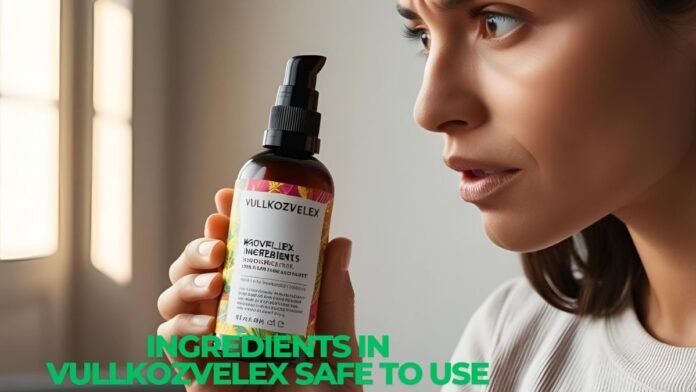In the realm of pharmaceuticals and nutraceuticals, understanding the composition and safety of products like Vullkozvelex is paramount. Consumers and healthcare professionals alike seek transparency regarding the ingredients to ensure efficacy and safety. This article delves into the known components of Vullkozvelex, evaluates their safety profiles, and addresses common questions surrounding its use.
Introduction
Vullkozvelex has garnered attention in the health community, prompting inquiries about its composition and safety. While specific details about Vullkozvelex are limited in publicly available sources, we can explore similar products and their ingredients to provide a comprehensive understanding. This exploration aims to shed light on the safety and efficacy of such products, guiding consumers and professionals in making informed decisions.
Read More: Locating the Xevotellos Model Number | A Comprehensive Guide
Common Ingredients in Similar Products
Products akin to Vullkozvelex often contain a blend of vitamins, minerals, amino acids, and herbal extracts. These components are selected for their potential health benefits. Below is an overview of commonly included ingredients:
- Vitamins and Minerals:
- Vitamin A: Essential for vision, immune function, and skin health.
- Vitamin D3: Supports bone health and immune system functionality.
- Vitamin E: Acts as an antioxidant, protecting cells from damage.
- B-Vitamins (B1, B2, B6, B12): Crucial for energy production and neurological functions.
- Vitamin C: Enhances immune defense and acts as an antioxidant.
- Calcium Gluconate: Provides calcium, vital for bone strength and muscle function.
- Magnesium Sulfate: Involved in muscle and nerve functions.
- Zinc Sulfate: Supports immune function and wound healing.
- Amino Acids:
- L-Lysine: Aids in protein synthesis and immune function.
- DL-Methionine: Supports liver health and metabolism.
- Herbal Extracts:
- Emblica Officinalis (Amla): Rich in vitamin C, supports immune health.
- Shatavari: Traditionally used to support reproductive health.
- Jeevanthi: Known for its rejuvenating properties.
Safety Profiles of Key Ingredients
Understanding the safety of each ingredient is crucial for assessing the overall safety of the product.
- Vitamins and Minerals: When consumed within recommended dietary allowances, these nutrients are generally safe. However, excessive intake can lead to adverse effects. For instance, hypervitaminosis A can cause liver damage, while excessive zinc may result in gastrointestinal disturbances.
- Amino Acids: Amino acids like L-Lysine and DL-Methionine are typically safe when consumed in appropriate amounts. Overconsumption, however, may lead to imbalances and side effects such as gastrointestinal discomfort.
- Herbal Extracts: Herbs like Amla and Shatavari have been used traditionally and are considered safe for most individuals. Nonetheless, potential interactions with medications and individual allergies should be considered.
Regulatory Oversight and Quality Assurance
The safety of nutraceuticals and supplements is often ensured through regulatory frameworks. In Pakistan, the Drug Regulatory Authority oversees the enlistment and quality of such products. For instance, products like Exocal-D and Exact MV have undergone such processes, ensuring compliance with safety standards.
Addressing Common Concerns
1. Are the ingredients in Vullkozvelex safe for long-term use?
While specific data on Vullkozvelex is limited, the safety of its common ingredients depends on adherence to recommended dosages. Long-term use should be monitored by healthcare professionals to prevent potential nutrient imbalances or toxicities.
2. Can Vullkozvelex interact with prescription medications?
Certain vitamins, minerals, and herbal extracts can interact with medications. For example, vitamin K can affect blood thinners, and calcium supplements may interfere with antibiotic absorption. Consulting a healthcare provider before combining supplements with prescription medications is advisable.
3. Is Vullkozvelex suitable for pregnant or breastfeeding women?
Pregnant or breastfeeding women should exercise caution with supplements. While nutrients like folic acid are beneficial, others may pose risks. It is essential to consult a healthcare provider before using such products during pregnancy or lactation.
4. How should Vullkozvelex be stored to maintain its efficacy?
Supplements should be stored in a cool, dry place away from direct sunlight to preserve their potency. Always follow the storage instructions provided on the product label.
5. What should I do if I experience adverse effects after taking Vullkozvelex?
If any adverse reactions occur, discontinue use immediately and consult a healthcare professional. Reporting the adverse effects to local health authorities can also help monitor the product’s safety.
Conclusion
While specific information on Vullkozvelex is limited, understanding the general safety profiles of similar products’ ingredients can provide valuable insights. It is crucial to adhere to recommended dosages, consider potential interactions with medications, and consult healthcare professionals before starting any new supplement. Regulatory oversight plays a vital role in ensuring product safety, but individual vigilance remains key to maintaining health and well-being.
